

Josh Nevett
2025 Bentley Bentayga review
5 Days Ago
Now that Tesla has axed the Model X here, Kia has picked up the mantle by offering a huge, flashy, tech-laden three-row SUV.
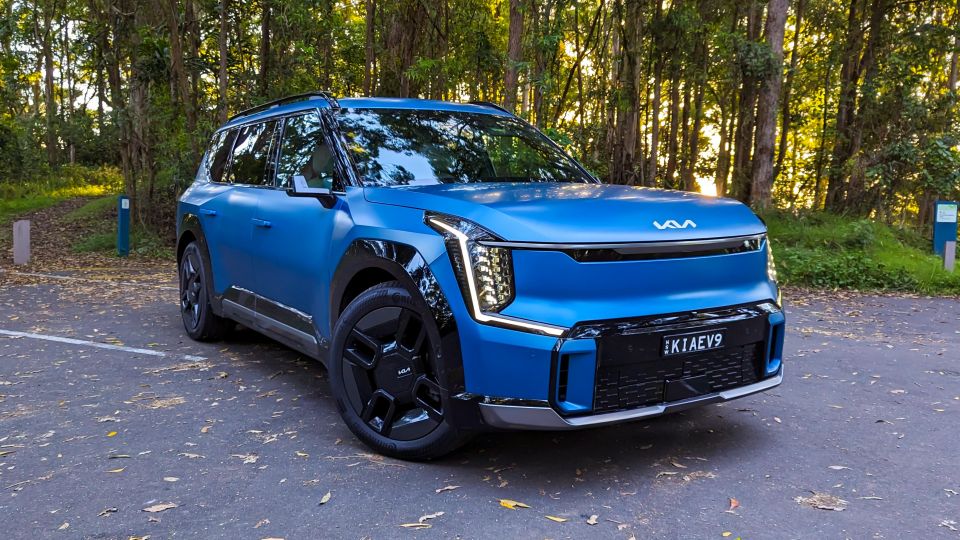
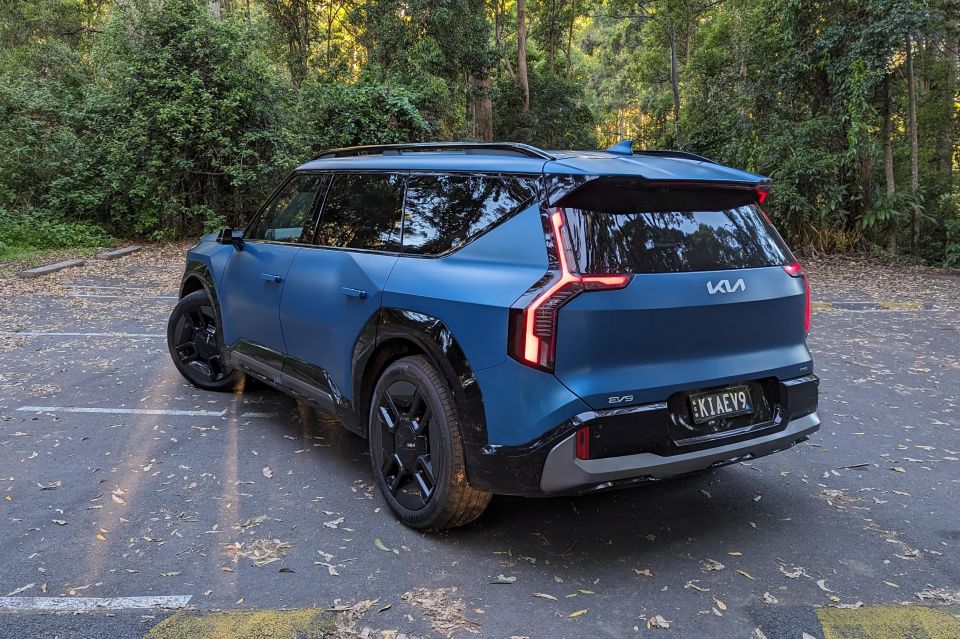

Quickly see how this car stacks up against its competition. Select any benchmark to see more details.
Where expert car reviews meet expert car buying – CarExpert gives you trusted advice, personalised service and real savings on your next new car.
There’s been a lot of activity in the mid-sized electric SUV segment, but large electric SUVs – at least those without luxury nameplates – are few and far between.

Enter the hulking 2024 Kia EV9, which measures just over 5.0 metres long – around the same size as a Toyota LandCruiser 300 Series – and is priced above $100,000 drive-away, even in base guise.
While some brands seem to want to make their EVs either look like blobs or just facsimiles of their combustion-powered cars, Kia has taken a different route.
The EV9 looks remarkably like the concept that previewed it, with its squared-off lines and bulging fenders. Our tester’s matte blue exterior finish makes it look even more like the original concept.
This SUV has serious presence, and it’s bluff and imposing without just looking like a box on wheels.
If the design is a deal-breaker for you but you want an electric three-row SUV right now, you’re out of luck. You can get a considerably smaller Mercedes-Benz EQB, or a considerably more expensive EQS SUV.
The Tesla Model X is dead in Australia, and the EV9’s Ioniq-badged platform-mate isn’t due in Hyundai Australia showrooms until later this year.
The Kia and its upcoming Hyundai sibling, previewed by the 2021 Seven concept, are the largest vehicles on the Hyundai Motor Group’s E-GMP dedicated electric vehicle (EV) architecture.
They’re considerably larger than platform-mates like the Hyundai Ioniq 5 and Ioniq 6 and Kia EV6.
There are three EV9s on offer.
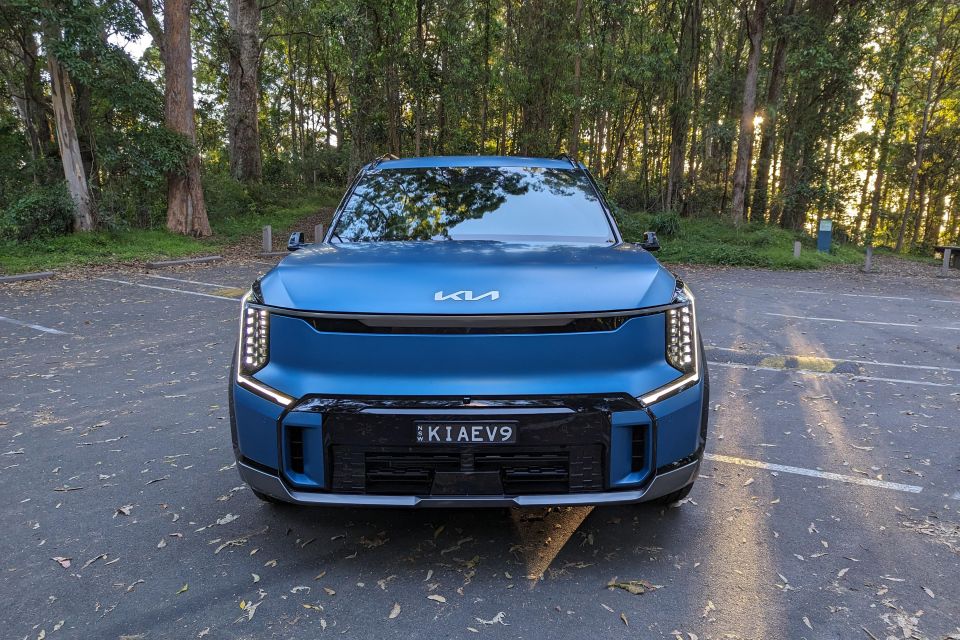
2024 Kia EV9 pricing:
Prices exclude on-road costs
To see how the Kia EV9 compares with its rivals, use our comparison tool.
The EV9 is an electric counterpart of sorts to the Kia Telluride, a large three-row crossover, closely related to the Hyundai Palisade, which isn’t sold here.
There’s no Telluride or Palisade that offers the kind of acceleration on offer with the EV9, and the electric Kia – which is completely unrelated mechanically – also boasts some exclusive features.
However, for comparison’s sake, the $121,000 before on-roads price of our GT-Line, which works out to be $140,200 drive-away, is just over $41,000 more than the most expensive Hyundai Palisade.
The Kia EV9’s interior is clean and modern but, while it doesn’t feel cheap, it isn’t what we’d call luxurious in terms of materials.
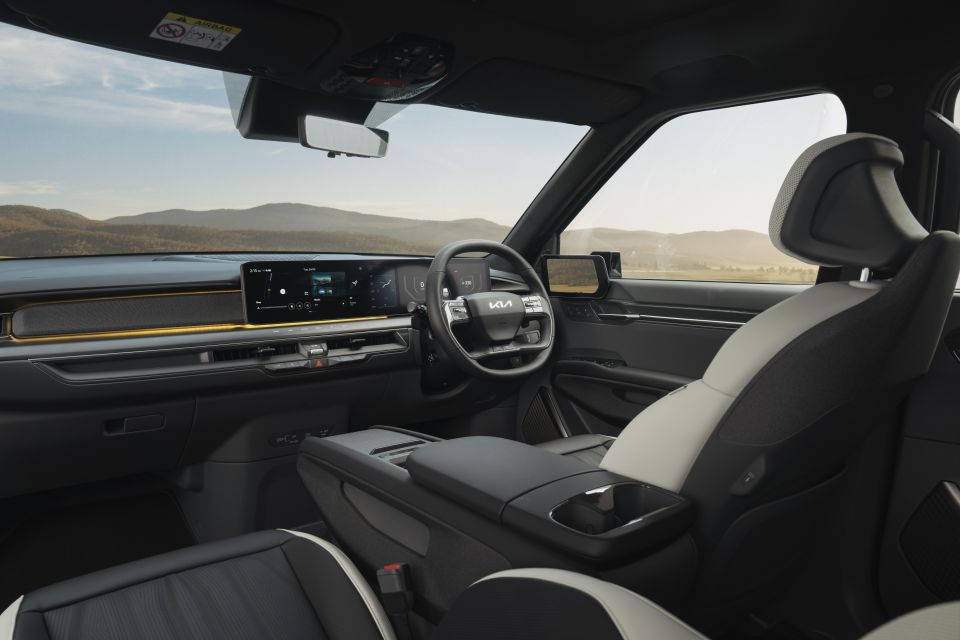
Nevertheless, it manages to avoid looking like any other Kia.
There’s lots of smooth-grained, soft-touch plastic, reminiscent of a Hyundai Ioniq 5. While it’s nicer than a Kia EV6 with its hard plastic dash, there’s not a sea of leather and neat stitching details like you might expect in a $100,000+ SUV.
Fabric inserts can be found on the doors, dash and on the sides of the centre console in the GT-Line, and serve to break up this plastic. There are also metal-look accents on the dash, as well as gloss grey trim.
Unlike the other members of the EV9 range, the GT-Line features a black suede (instead of grey fabric) headliner. There are also alloy pedals and sill plates.
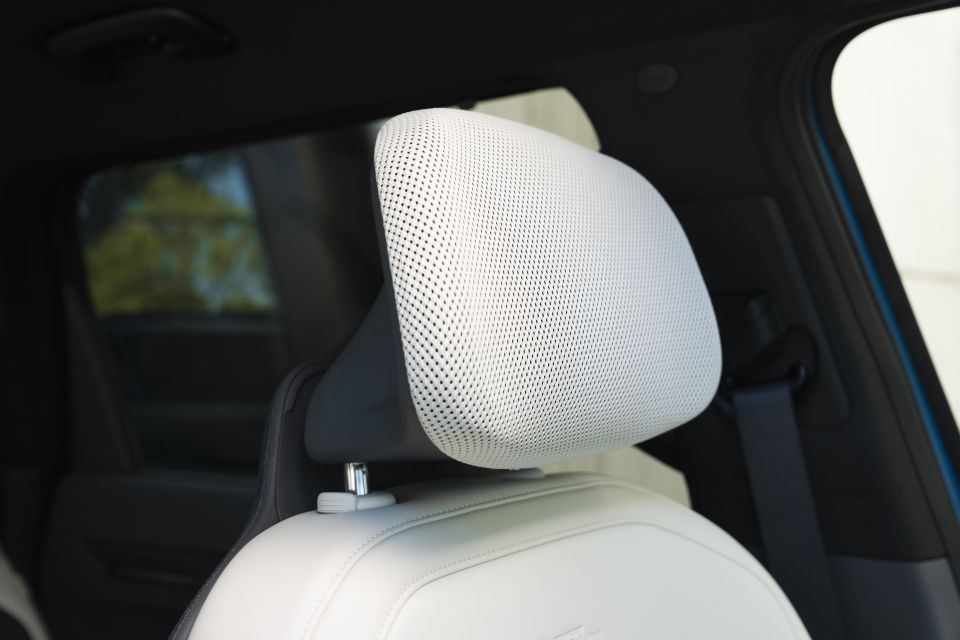
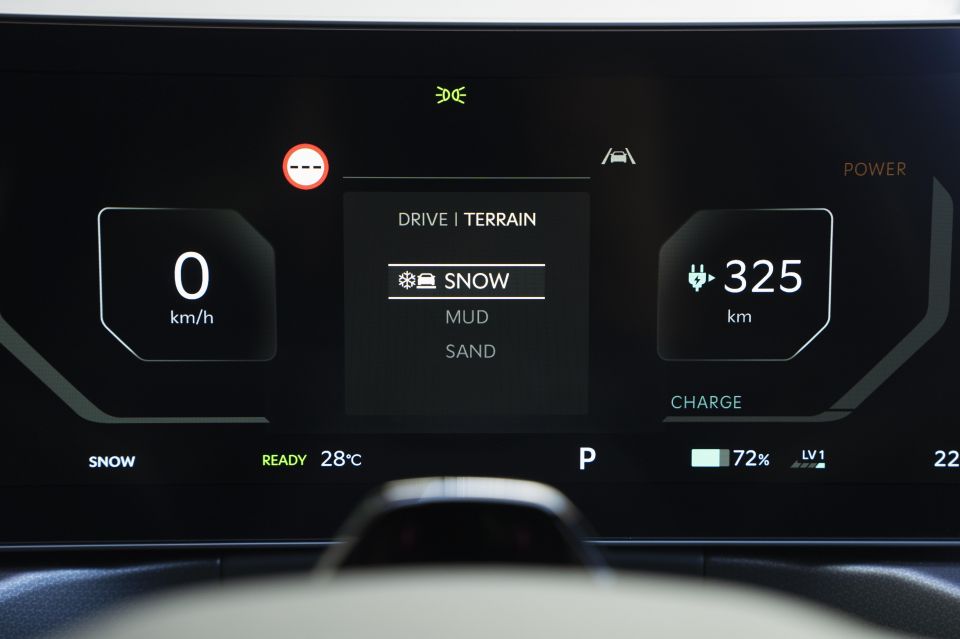
Also improving the ambience is the extensive ambient lighting, which allows you to select colours for two different zones for a rather Mercedes-Benz-like effect. The illuminated Kia logo on the steering wheel is a neat touch, too. Both of these features can be found on the mid-range Earth.
The front seats have an attractive two-tone treatment, distinctive mesh headrests, and feature heating, ventilation and, for the driver only, an excellent massage function.
The GT-Line uniquely gets ‘Premium Relaxation’ seats with two-way power leg rests, four-way power lumbar and power-adjustable bolsters. That means they’re both comfortable when you’re driving, but also a delight when you’re relaxing in your car waiting for it to finish charging.
There’s a subtly patterned trim piece stretching across the dash that contains touch-capacitive shortcut buttons for functions like the satellite navigation. These are backlit when the car is on, and have haptic feedback when you press them – though you’ll need to give them a firm press.
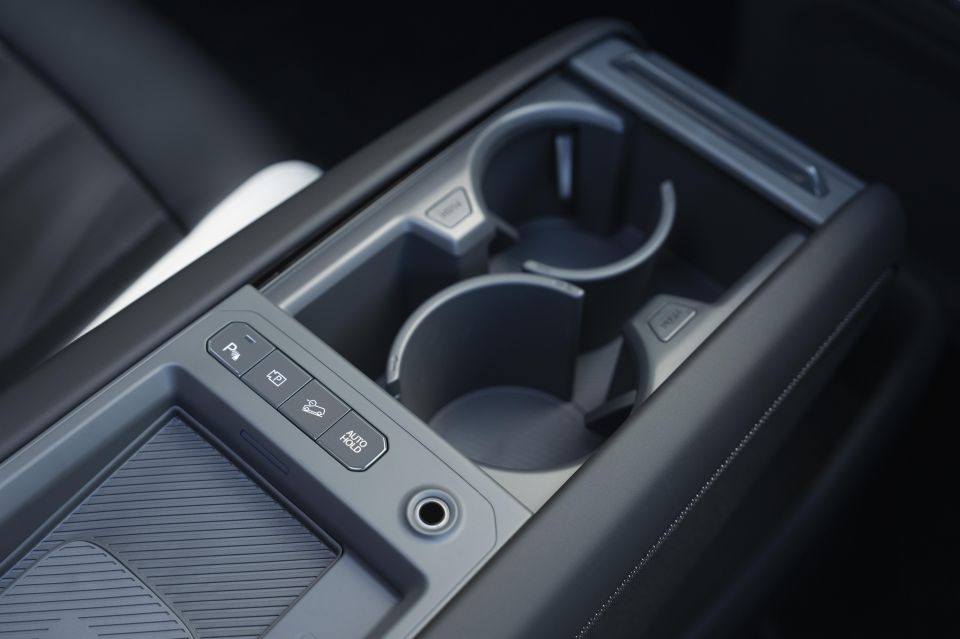
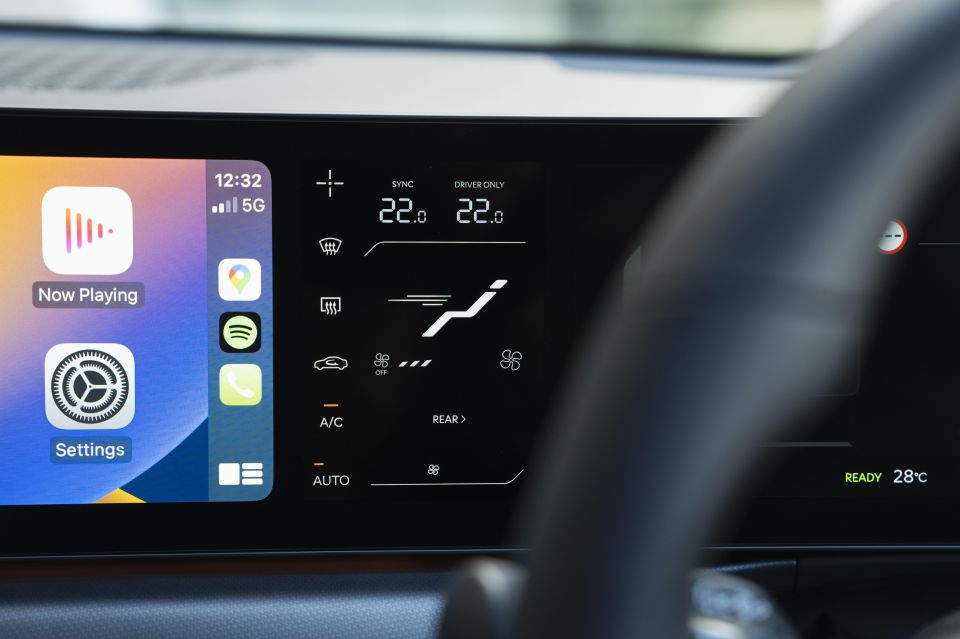
There’s still some traditional switchgear on the dash, including simple buttons for adjusting fan speed and temperature, and a metallic roller wheel for adjusting volume. On the doors, you’ll find physical switches for features like the heated and ventilated seats.
These are all tactile, as are the metallic switches on the steering wheel.
Speaking of the steering wheel, the illuminated Kia logo is a neat touch.
While the switches for fan speed and temperature are easy to access and use, the climate control screen itself isn’t. It sits between the infotainment touchscreen and digital instrument cluster, which means it’s blocked by the steering wheel… unless you have a very, very different seating position to me.
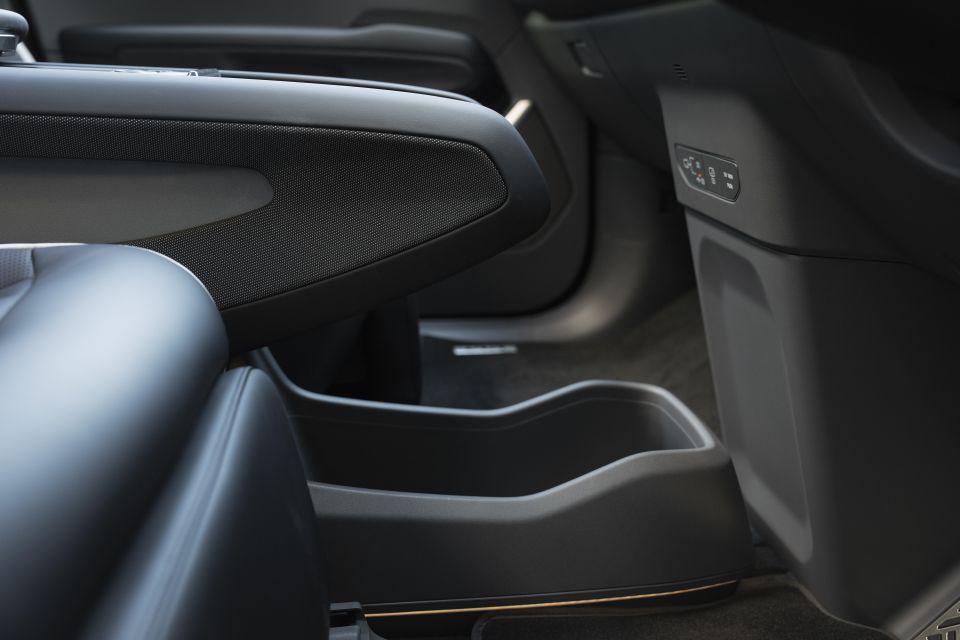
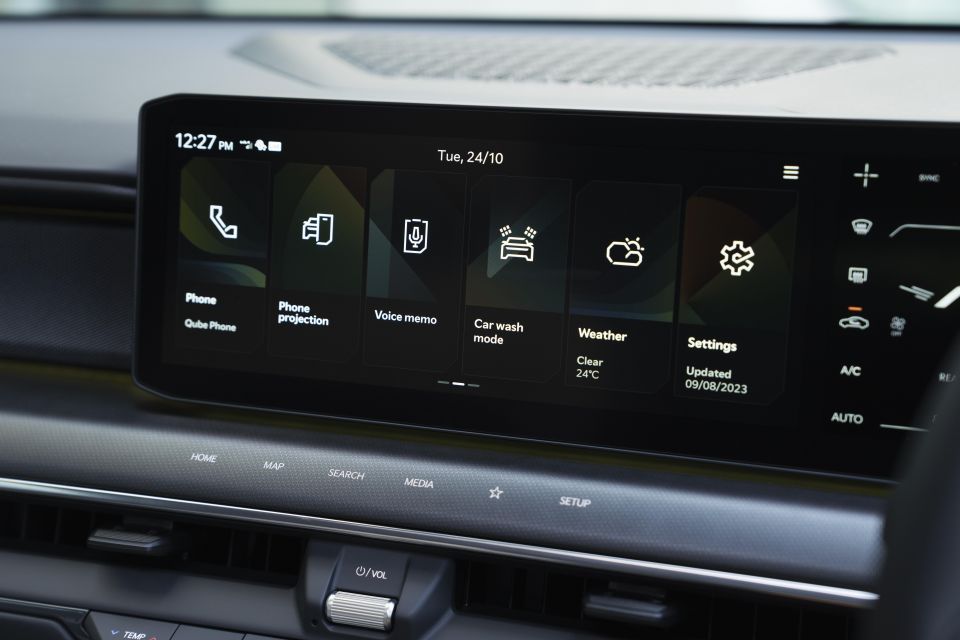
The digital instrument cluster has neat graphics but there’s no map view like you’ll find in various European vehicles. You may not look at it all that much, though, as there’s an excellent head-up display.
The infotainment system is excellent, apart from the peculiar absence of wireless connectivity – at least for now – for Android Auto and Apple CarPlay. Both nicely fill up the 12.3-inch screen.
Response times are quick and menus are intuitive. All that needs to be fixed is the annoying user profile screen that appears when you start the car and which takes too long to go away.
We also noted a couple of interesting messages. When cleaning the windscreen, a message appeared on the touchscreen advising the scent of the washer fluid was automatically prevented from entering the cabin, while on another occasion the screen advised us the rear air-conditioning had been turned off as the vehicle (correctly) didn’t detect any rear-seat occupants.
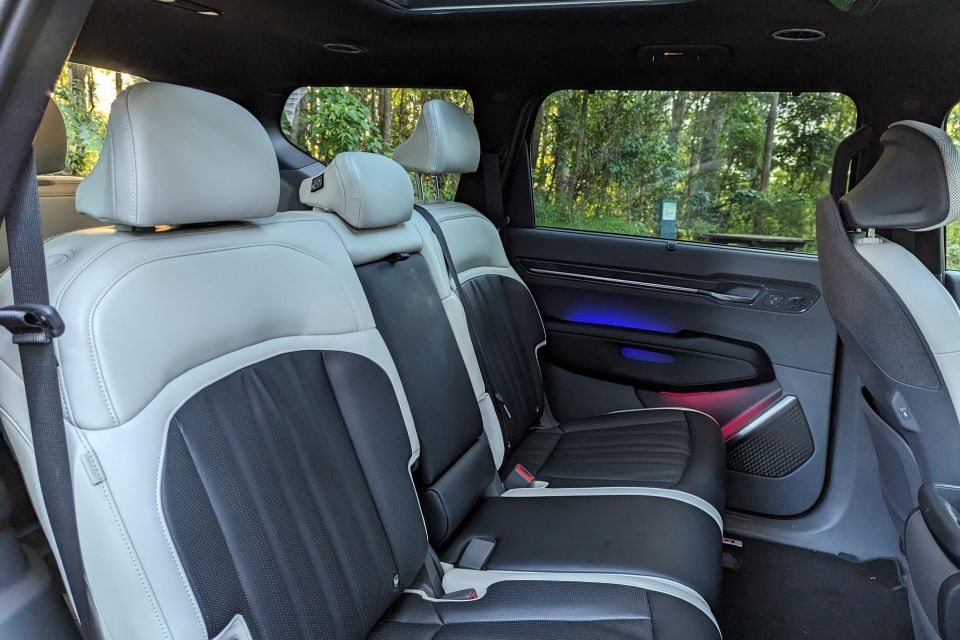
In terms of storage, there’s an expansive shelf underneath the centre console which helps make up for the fairly small centre console bin under the centre armrest next to the wireless charging pad.
There are two cupholders in the centre console which can be retracted to form a more open storage cavity, or concealed beneath a roller cover.
The second-row floor is flat, and the ambient lighting carries through to the back. There are USB-C outlets on the front seatbacks and air vents in the B-pillars, while there’s an unusually voluminous yet dark storage area at the rear of the centre console.
There’s plenty of room in every direction, and the second-row bench is comfortable. There’s a fold-down centre armrest with cupholders, plus manual sunblinds.
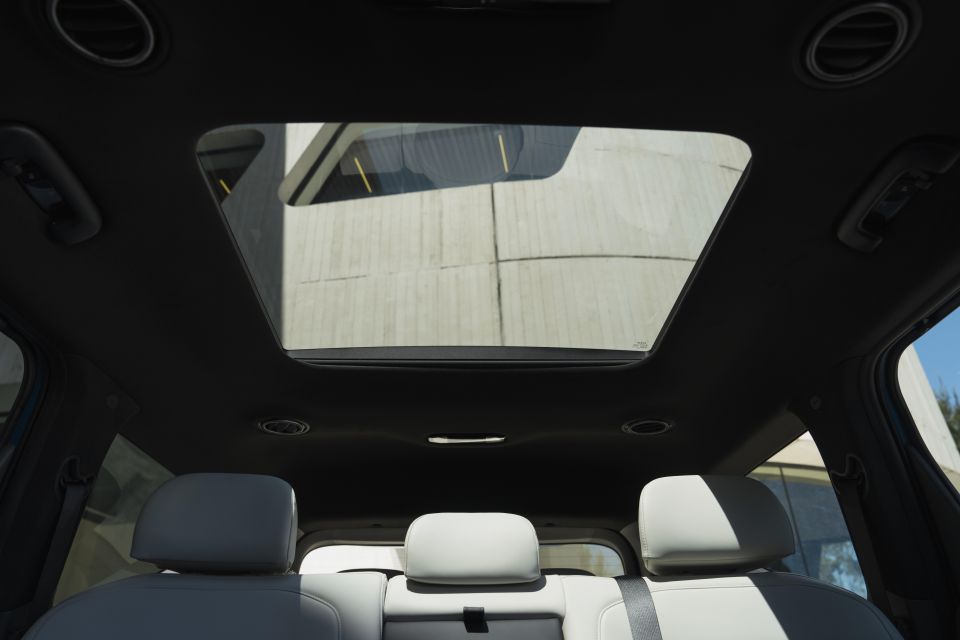

Vehicles on dedicated EV platforms are often touted as offering packaging superior to combustion-powered vehicles.
Perhaps that’s why I was expecting a huge third row, which the EV9 doesn’t have. A Palisade or Grand Cherokee L is arguably more comfortable back here for adults.
You can make it work, though. The third-row occupants of the EV9 will need to ask their friends in the second row to scooch their seat forward a bit. It’s possible to have adults sit in both the second and third rows, provided they’re not NBA players.
With the second row in its regular position, I couldn’t sit in the third row without my knees being pressed firmly against the second row seatbacks, and I’m 180cm tall.
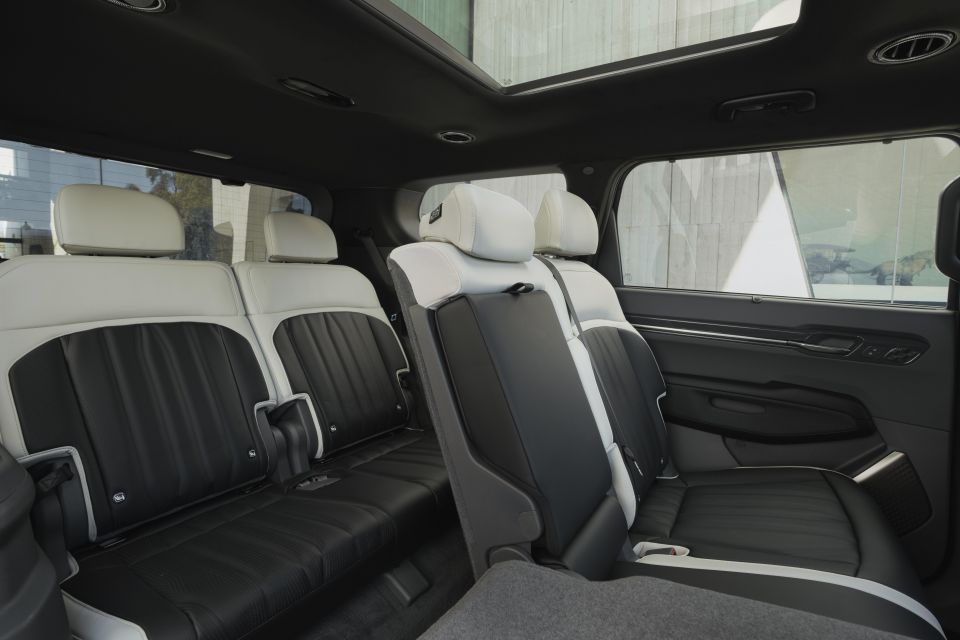
Headroom is great, however, owing to the car’s boxy shape.
In terms of amenities, there are two cupholders and one USB-C outlet on either side, plus air vents. There are top-tether points for all second and third row seats, plus four ISOFIX anchor points across these rows.
Boot space is average. You can fit a large suitcase and a carry-on with the third row up, with the space measuring 333L. Dropping the third row, which is done by pulling the straps on the seatbacks, increases space to 828L.
You can drop the second row seats with the press of a button, further increasing cargo space to 2318L.
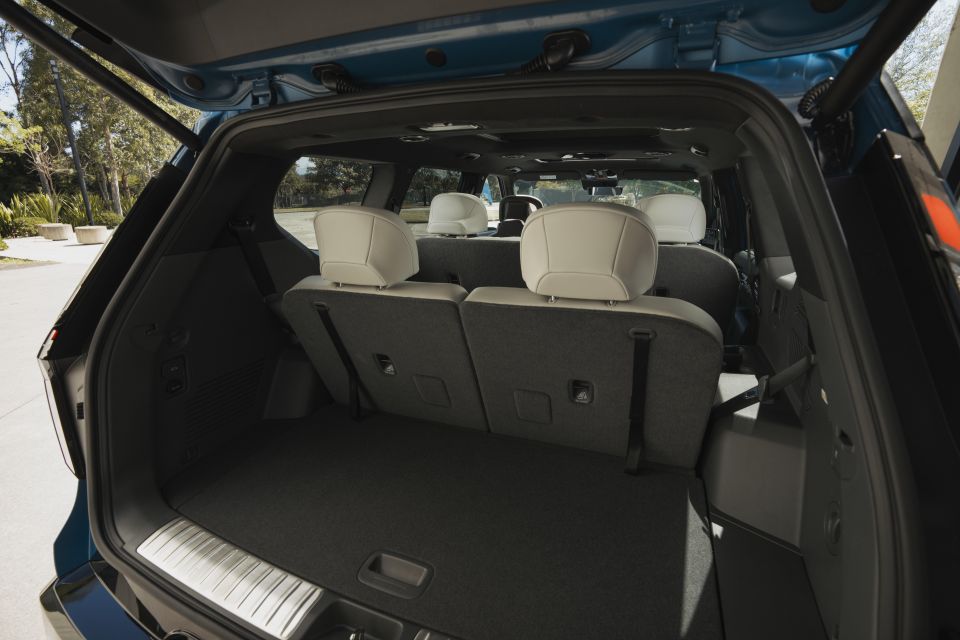
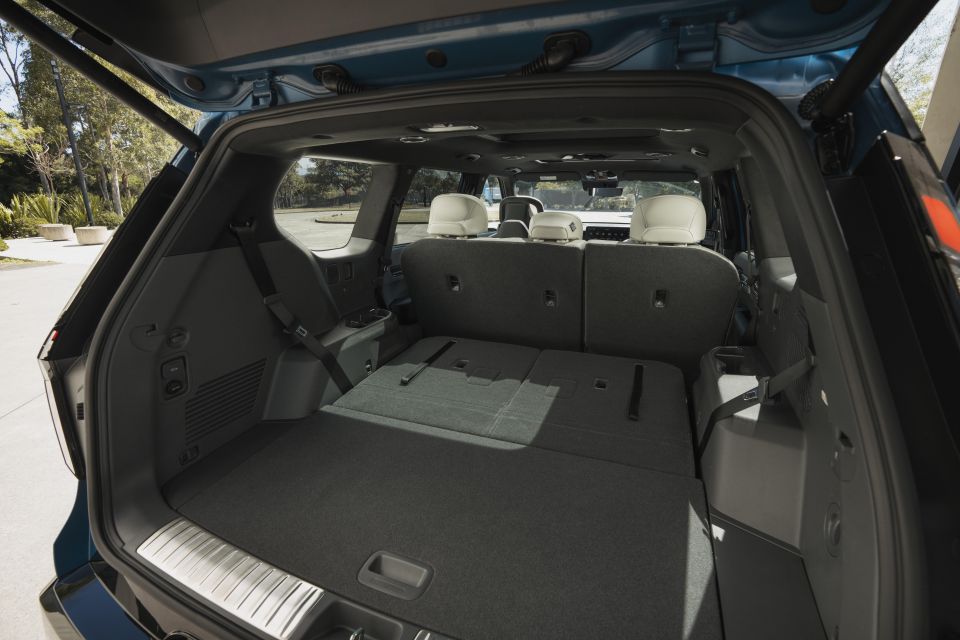
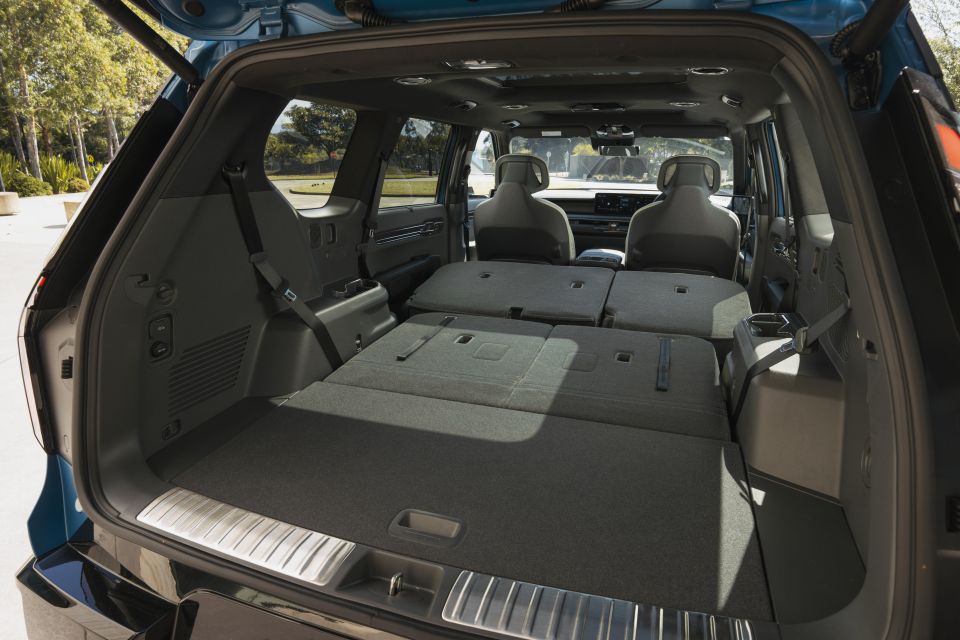
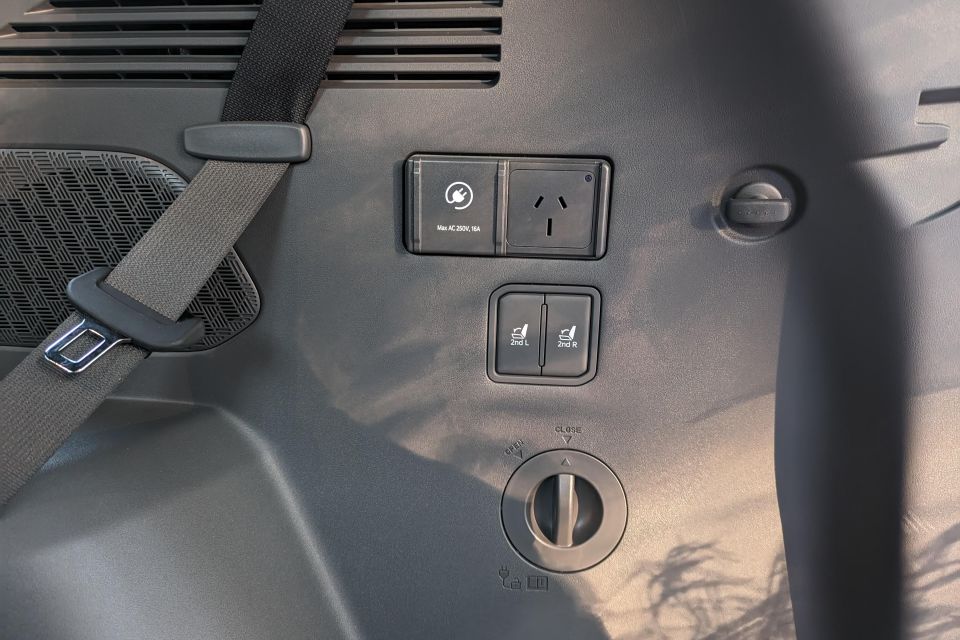
In the boot, you’ll find a 250V 16A outlet – handy if you want to, for example, charge a laptop – as well as a 12V 180W outlet, and switches to drop the second-row seats. Unlike other EV9s, the GT-Line also features an external vehicle-to-load (V2L) outlet.
As with most EVs, there’s no spare tyre. Instead, all you get is a tyre mobility kit.
Under the bonnet, there’s an illuminated 52L storage compartment. That’s down on the 90L in the rear-wheel drive Air, with the presence of a front electric motor necessitating a smaller compartment. It’s also rated to carry only 20kg, instead of 40kg, and goes without an accessory net.
The GT-Line shares its dual-motor all-wheel drive powertrain with the mid-range Air, though Kia claims a 0.7-second quicker 0-100km/h time.
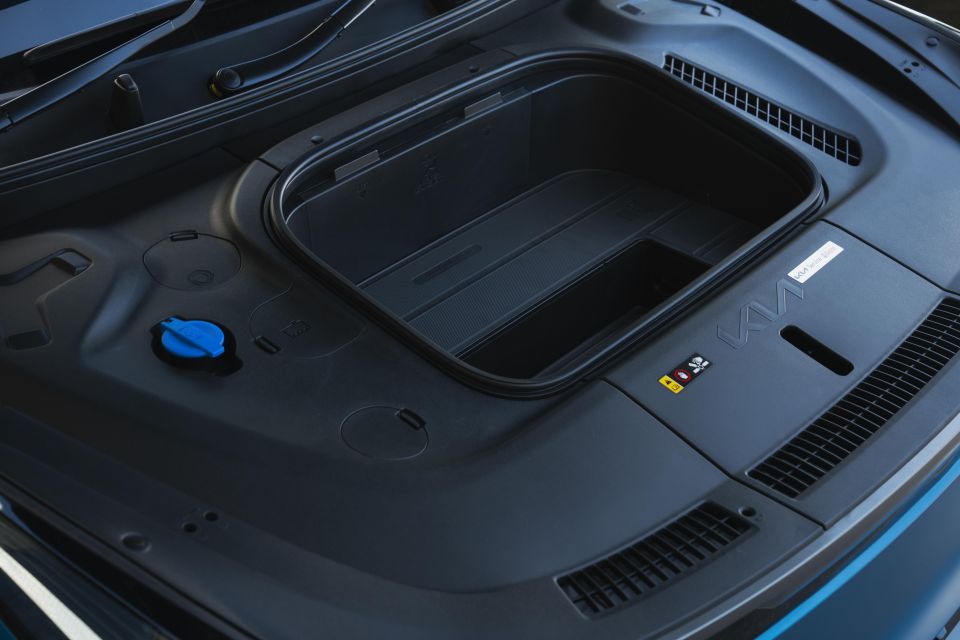
| Model | Kia EV9 GT-Line AWD |
|---|---|
| Drivetrain | Dual-motor electric |
| Battery | 99.8kWh lithium-ion |
| Power | 283kW |
| Torque | 700Nm |
| Driven wheels | All-wheel drive |
| 0-100km/h time (claimed) | 5.3 seconds |
| 0-100km/h time (as tested) | 5.21 seconds |
| Weight | 2636kg (tare) |
| Energy efficiency (claimed) | 22.8kWh/100km (WLTP) |
| Energy efficiency (as tested) | 20.8kWh/100km (city, highway, suburban loop) 22.2kWh/100km (over the course of a week) |
| Claimed range | 505km |
| Max DC charge rate | 270kW |
To see how the EV9 compares with its rivals, use our comparison tool.
Kia engineers should be commended for making a car on giant 21-inch wheels ride this well without adaptive or air suspension.
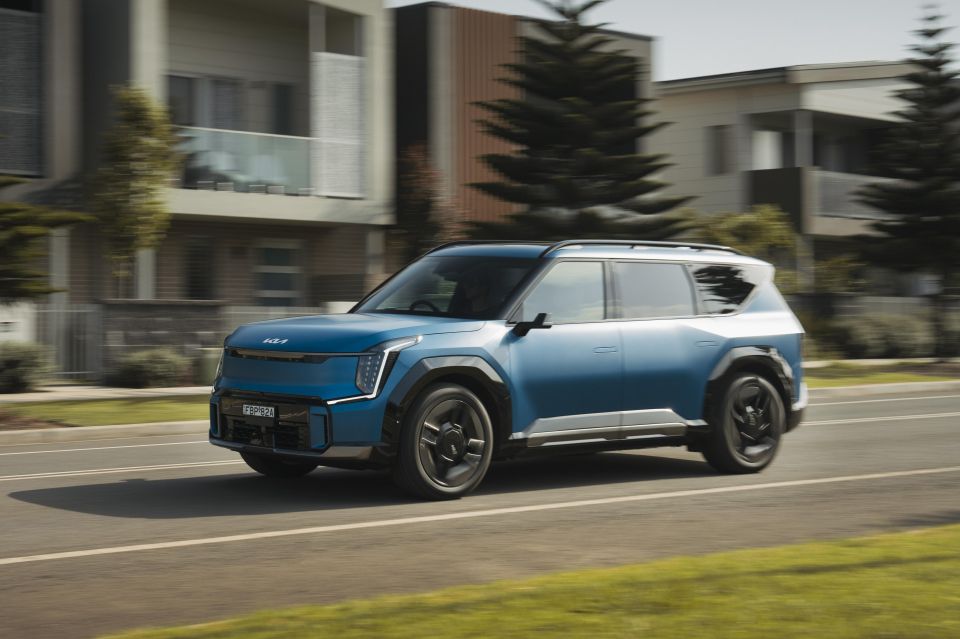
We’ve driven some Hyundai Motor Group products on larger wheels that can have a stiff feel over bumps and ruts, and yet have a floaty feel to their suspension.
Not so the EV9. As you ride over bumps and ruts, there are just muffled thumps with no impact harshness, while the vehicle also feels nicely tied down. Pockmarked roads are dispatched with no drama.
It gets a little more terse on an unsealed road, but it’s still comfortable. There’s little if any penalty on ride comfort exacted by the 21s compared with the 19-inch wheels on the base Air.
For something that weighs over two and a half tons and rides a 3100mm wheelbase, the EV9 is also impressively nimble.
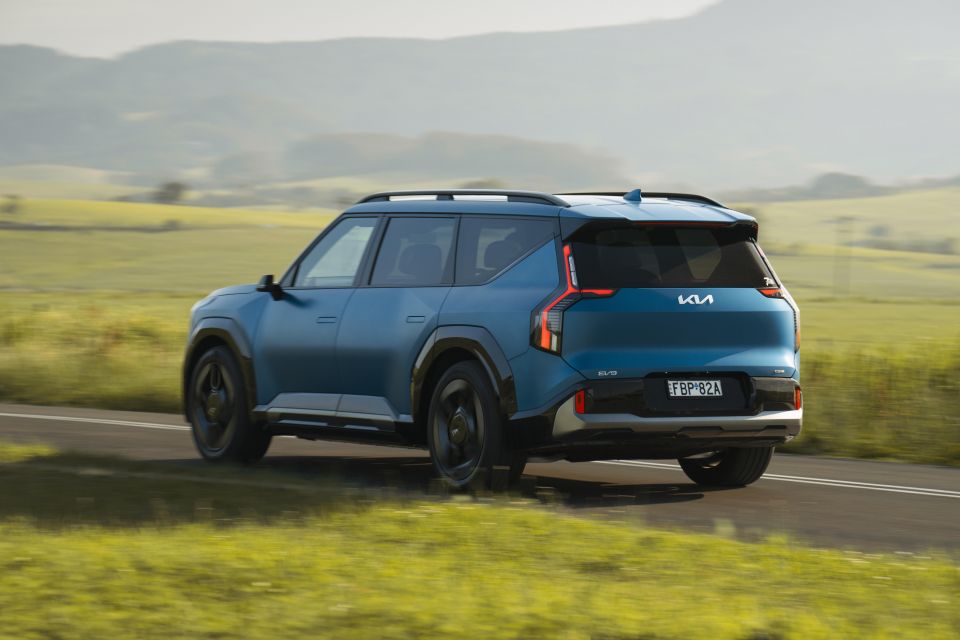
Where expert car reviews meet expert car buying – CarExpert gives you trusted advice, personalised service and real savings on your next new car.
It seems to shrink around you, as a drive along a winding mountain road proved. The steering has a nice, progressive weighting to it, even if it mightn’t be the last word in road feel, and you can throw this big bus into tight corners without things going pear-shaped.
But where the EV9’s outsized dimensions are painfully apparent is in a parking lot. That long wheelbase makes this car a pain to park, even if the steering is sufficiently light. The turning circle is 12.4m.
There’s an automated parking system that can identify and manoeuvre into both parallel and perpendicular spots. You can also have it locate a spot and get out of the car, holding down a button on the key fob to watch it manoeuvre into the spot. It’s a neat party trick, even if it’s not all that useful.
The GT-Line is properly quick, doing the 0-100km/h dash in 5.3 seconds. That’s rapid for something this big and heavy, and yet Kia still plans to launch an almost certainly quicker GT model!
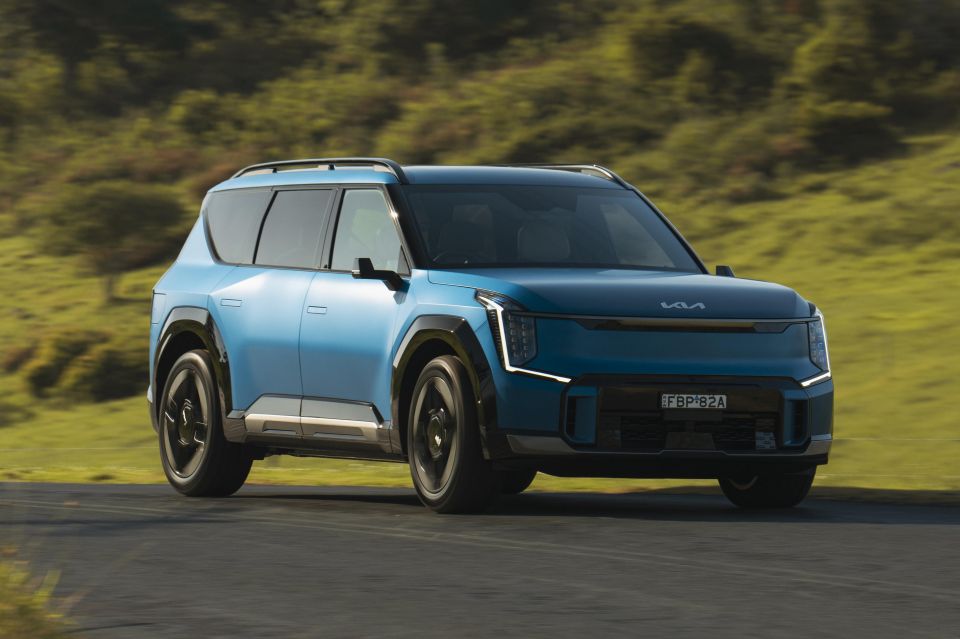
There’s immediate torque on tap in typical EV fashion, and the EV9 gets its power to the ground smoothly and effortlessly.
You can turn on a fake propulsion sound, which was cool for about 10 minutes. I then turned it off and never activated it again.
Instead, I just enjoyed the virtually imperceptible whir of the electric motors. The cabin is quiet, with wind and tyre noise well suppressed.
There’s a little tyre roar on coarse-chip roads, but not so much that you can’t easily have a conversation with your passengers.
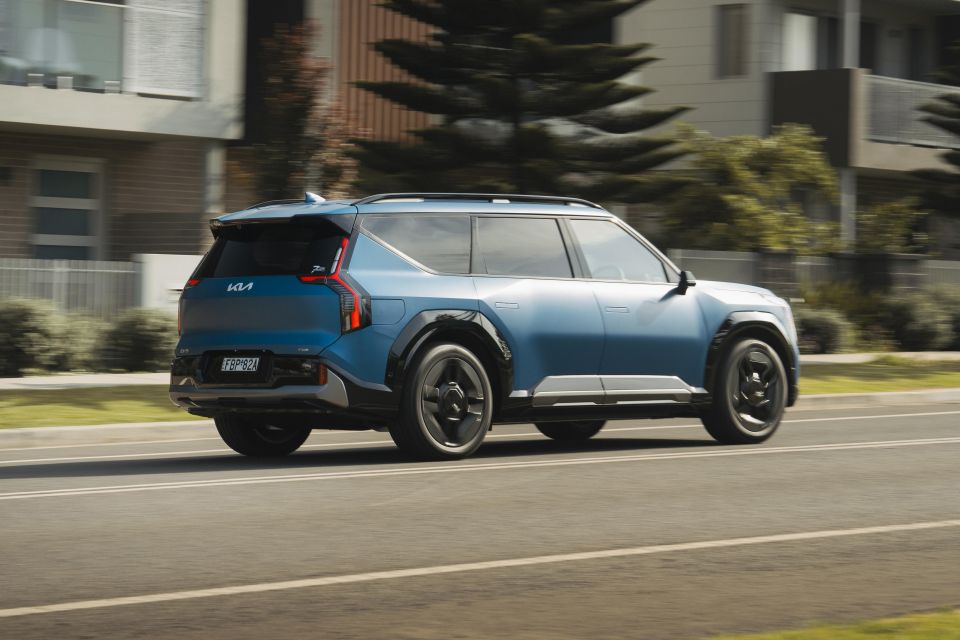
The GT-Line gets three additional drive modes, with Snow, Mud and Sand joining Eco, Normal, Sport and My Drive Mode.
In Kia fashion, the lane-keep assist and lane centring are rather over-eager, but they know what they’re doing; even curvy off-ramps are no problem for the latter.
The Highway Driving Assist, which combines the adaptive cruise and lane centring systems, makes the freeway commute almost mindless.
As with other recent Hyundai Motor Group products, there’s an annoying overspeed alert that won’t shut up. It bings when it detects a new speed limit, it dings if you exceed it even only slightly, and is just an all-round pain in the behind. It also defaults to on, so you have to manually turn it off each time.
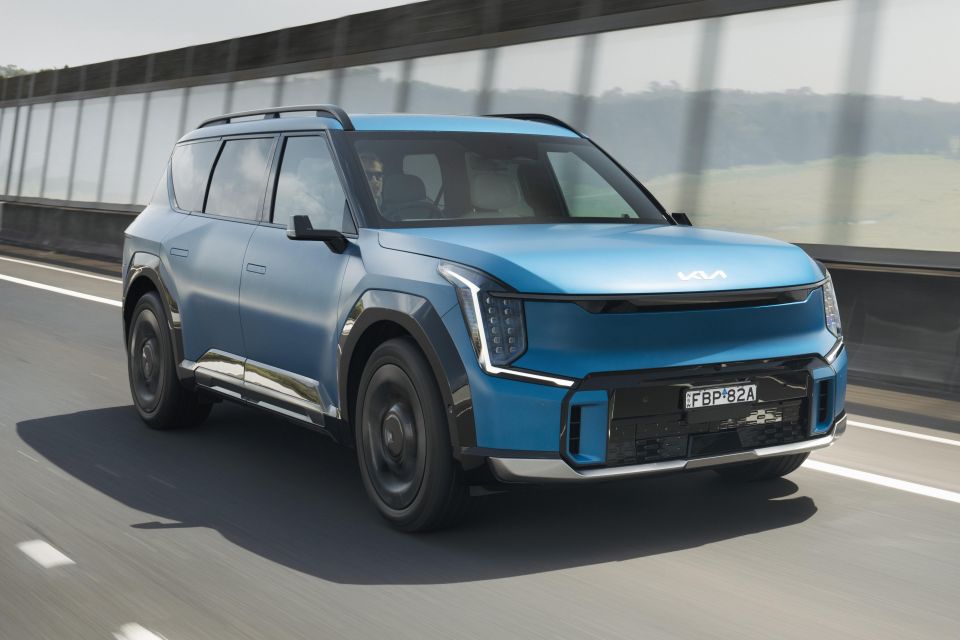
Kia’s handy star shortcut buttons can be programmed to take you to the driver assist systems menu so you can turn off this system (you can turn off the sounds and keep the speed sign readout active).
I went to program the star button to take me there, and found the previous driver had already done it. Clearly I’m not the only person who finds this system annoying.
The driver attention monitoring system accurately identifies whether you’re paying attention, though I found it chided me a couple of times for not looking ahead when I was merely looking down at the digital instrument cluster.
Kia’s Blind Spot View Monitor is an excellent idea, with camera footage of your blind spot appearing in the instrument cluster when you indicate in addition to the typical indicator lights in the exterior mirrors.
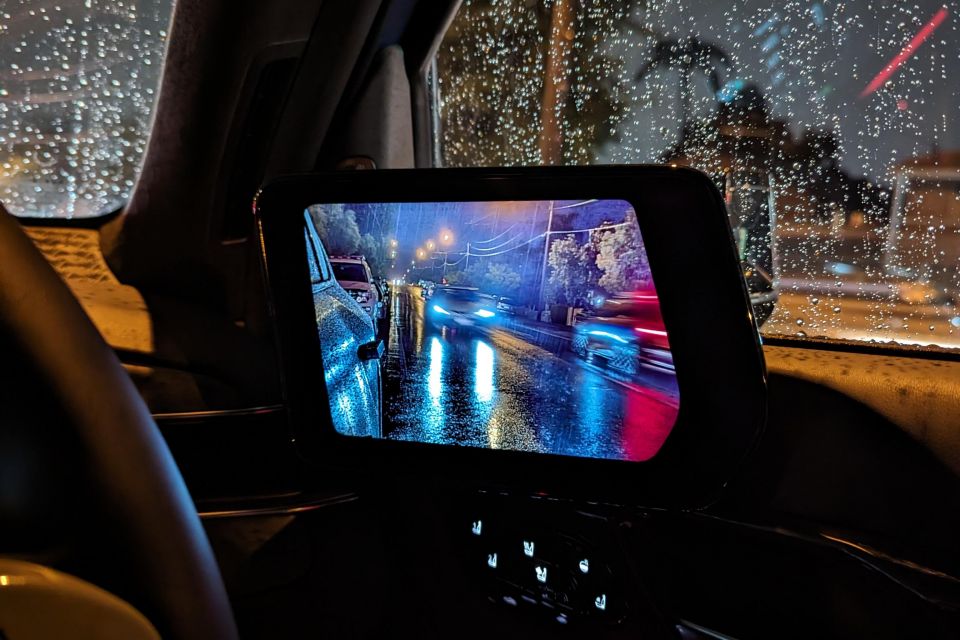
There’s a digital rear-view mirror, allowing you to pull a tab below the mirror to switch it to displaying camera footage of what’s behind you. That’s handy if you have a car loaded up with people and their belongings.
The digital camera mirrors are less useful. Sure, they’re a great conversation starter, but I’m struggling to think of one advantage they hold over typical mirrors.
When you go to change lanes, handy guidelines appear, so there’s that. But surely there are no efficiency gains here, given they stick out just as much as regular mirrors and don’t particularly look any more aerodynamic.
Unfortunately, if you get the GT-Line, you’re stuck with them.

On a blast through the mountains, I saw energy consumption of around 33kWh per 100km. Over a loop comprising inner-city, suburban and highway driving, we recorded consumption of 20.8kWh/100km, and this increased slightly to 22.2kWh/100km over the course of a week.
That’s close to the official WLTP claim of 22.8kWh/100km.
With 100 per cent charge, the EV9 GT-Line displayed range of 552km, though the official WLTP claim is 505km.
You can adjust the level of regenerative braking using the paddle shifters, though you’ll have to engage i-Pedal – Kia’s one-pedal driving mode – each time you start the vehicle. Again, this is done via the paddles.
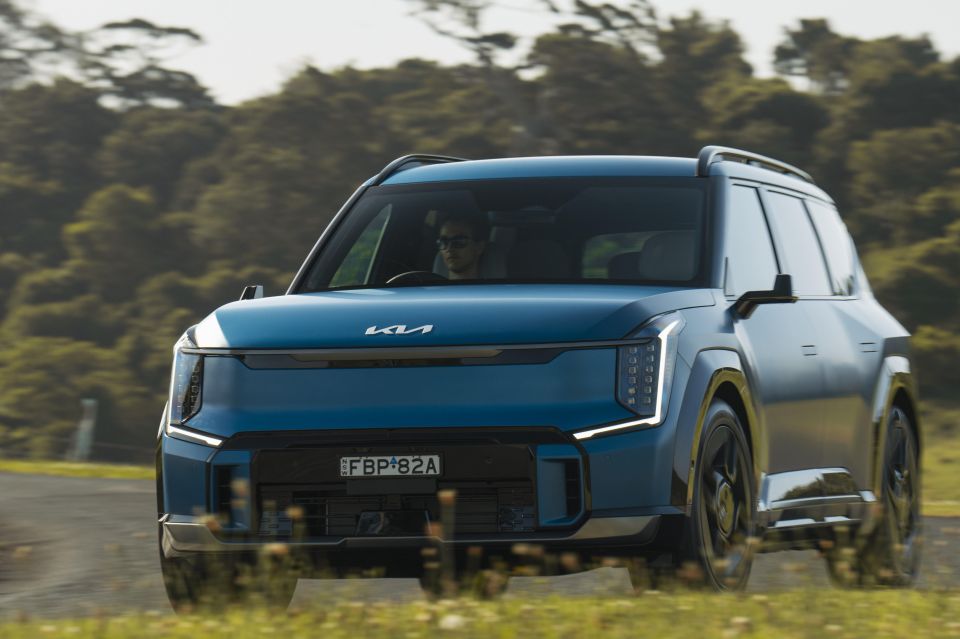
i-Pedal will bring the car to a stop, but it’s not among the more aggressive one-pedal systems out there.
Finally, we have to praise the adaptive LED headlights which not only look great, but work superbly by casting light far and wide without dazzling oncoming motorists.
There are three trim levels in the EV9 range, with the GT-Line sitting at the top for now.
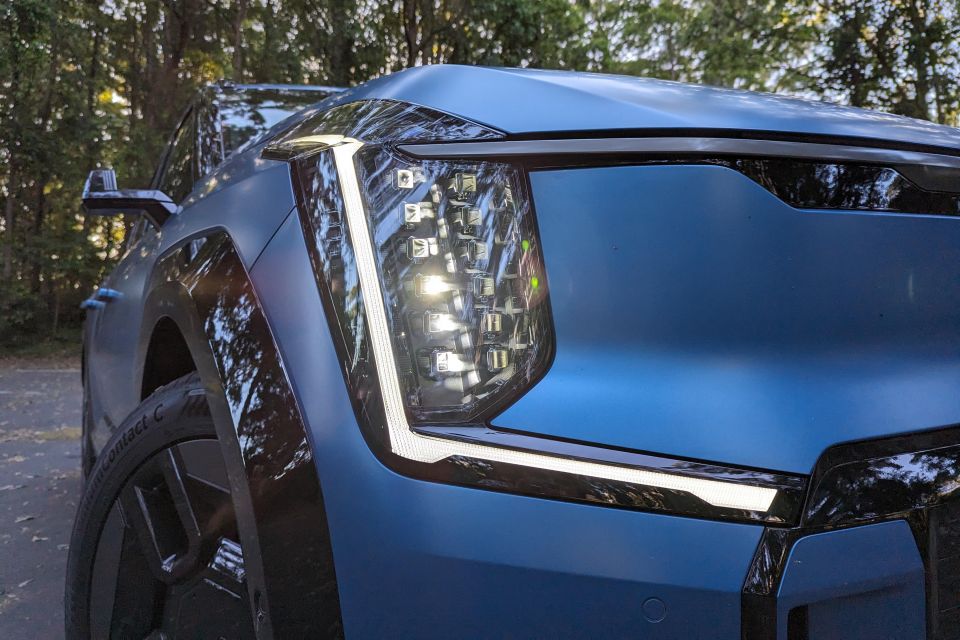

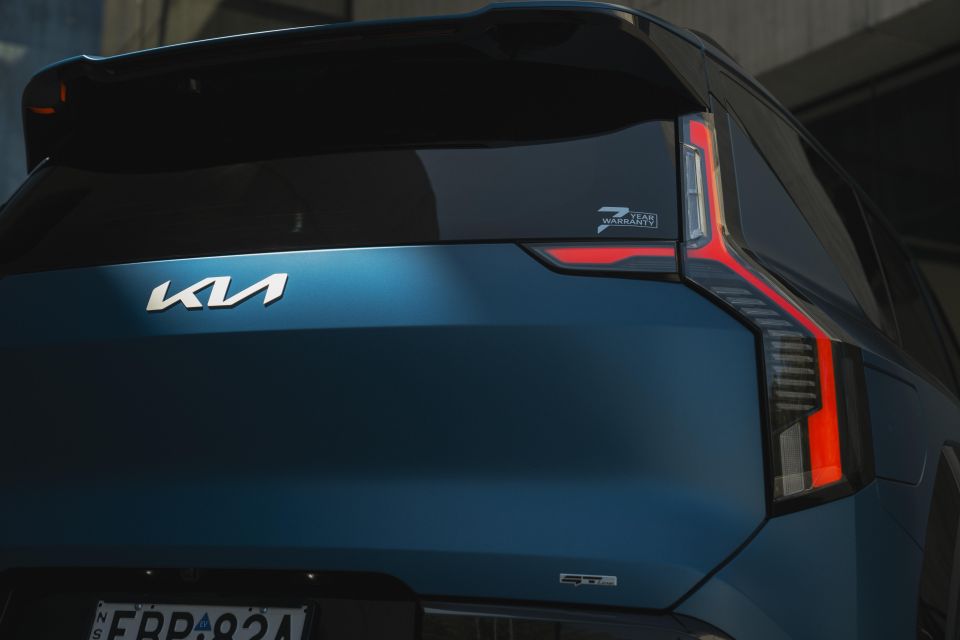
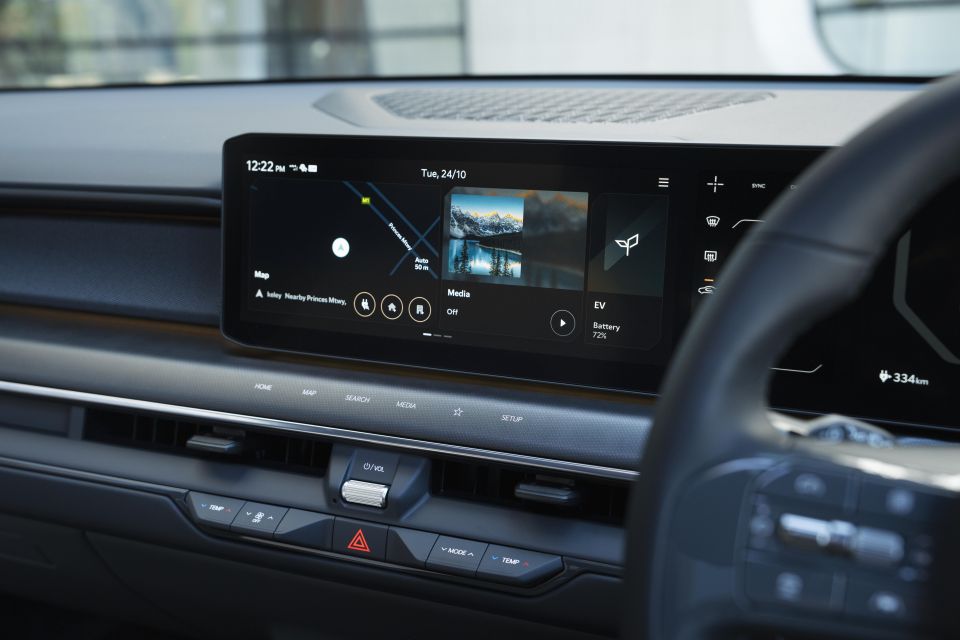
EV9 Air highlights:
EV9 Earth:
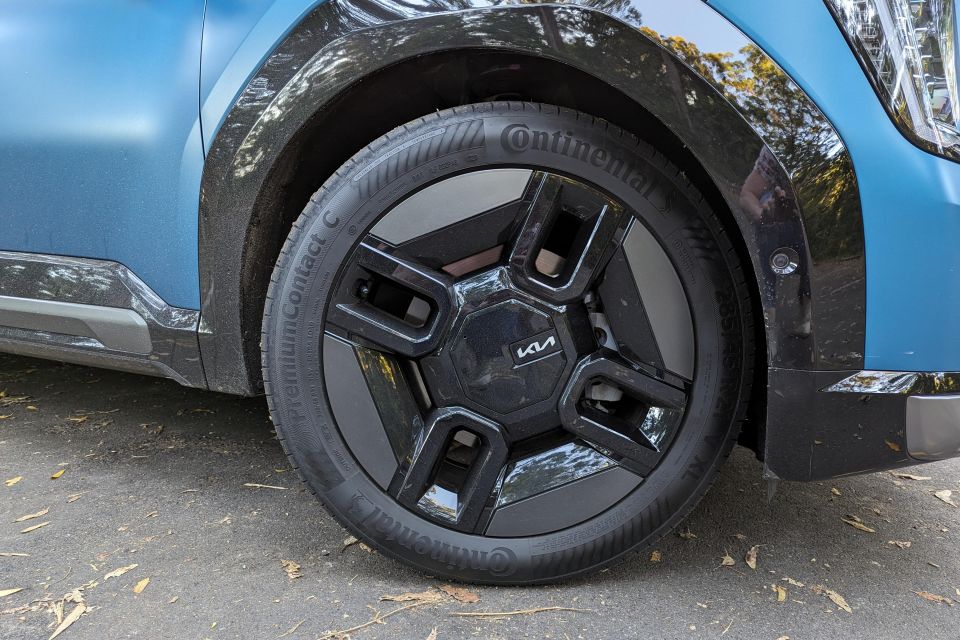

EV9 GT-Line:
The Kia EV9 has yet to be tested by ANCAP or Euro NCAP.

Standard safety equipment across the range includes:
EV9 Earth adds:
The GT-Line also features side and forward versions for the Parking Collision Avoidance Assist.
The Kia EV9 is backed by a seven-year, unlimited-kilometre vehicle warranty, with a seven-year, 150,000km warranty for high-voltage components like the battery and electric motors.

Kia offers a choice of three-, five- and seven-year pre-paid service plans. These are priced at $706, $1351 and $1997, respectively.
The EV9 is the largest vehicle Kia has ever sold here and the most expensive.
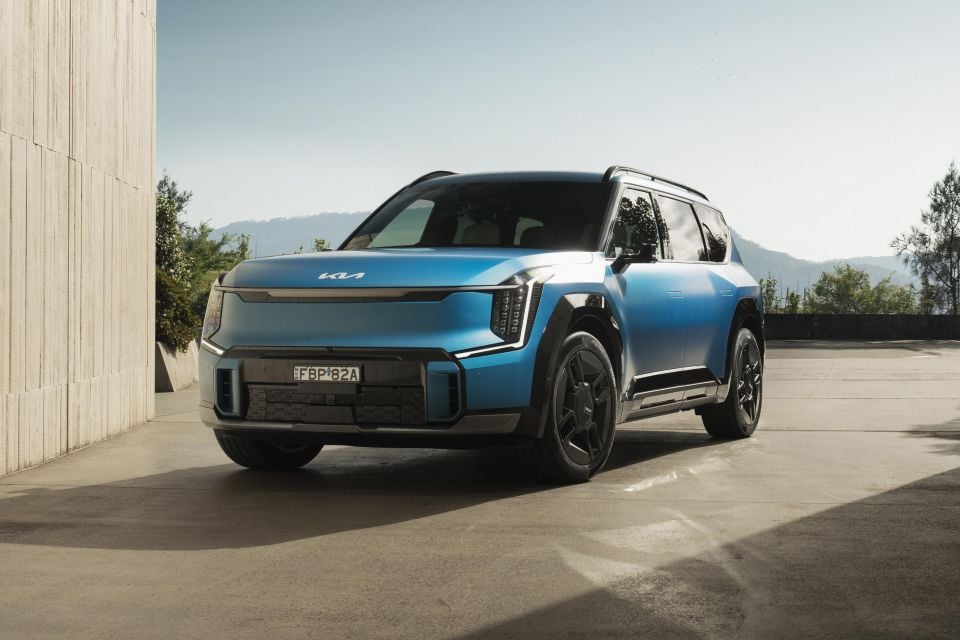
It’s also arguably the most impressive vehicle ever from the Korean brand, which has produced some genuinely appealing, aspirational vehicles like the Stinger, K9 and EV6.
From its show-stopping looks to its impressive technology, the Kia EV9 feels more like a concept car than your typical three-row SUV.
And yet it’s not just flash. There’s plenty of genuine substance here, from the surprisingly comfortable ride to the agile dynamics and the long list of safety equipment.
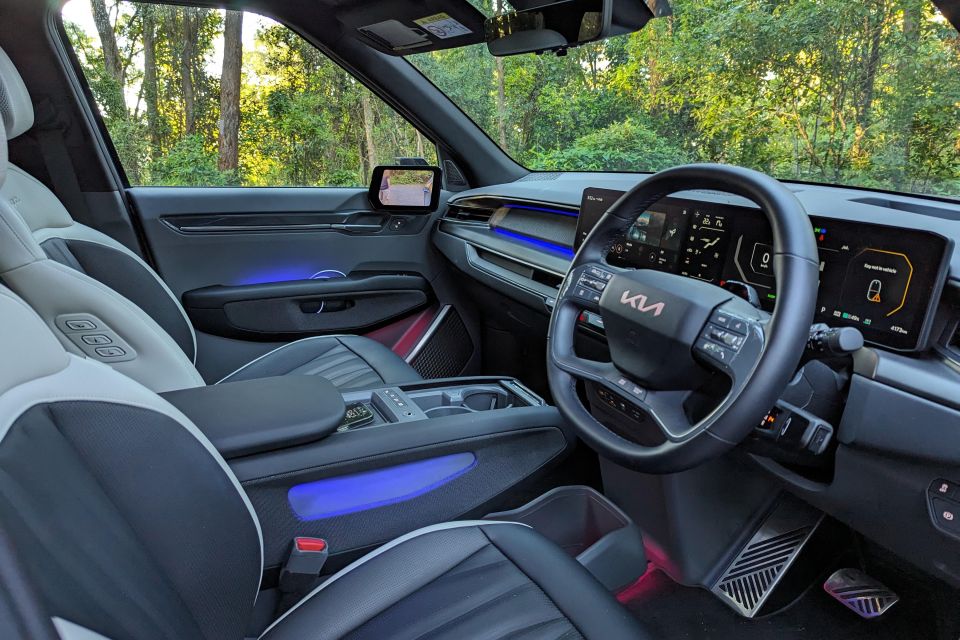
Our gripes are few, but include a rather small third row and overbearing safety assists.
However, while the EV9 has essentially no direct rivals, there’s still no getting around that lofty price tag.
The good news is less expensive EV9s are similarly impressive. Even the entry-level Air, despite being slower and lacking some of the GT-Line’s gadgets, is well worth looking at if you want to move to an electric SUV.

Click the images the full gallery
MORE: Buy a Kia EV9 MORE: Everything Kia EV9
Where expert car reviews meet expert car buying – CarExpert gives you trusted advice, personalised service and real savings on your next new car.
William Stopford is an automotive journalist based in Brisbane, Australia. William is a Business/Journalism graduate from the Queensland University of Technology who loves to travel, briefly lived in the US, and has a particular interest in the American car industry.


Josh Nevett
5 Days Ago


Andrew Maclean
4 Days Ago


Shane O'Donoghue
4 Days Ago


Anthony Crawford
3 Days Ago


Matt Campbell
2 Days Ago


James Wong
19 Hours Ago